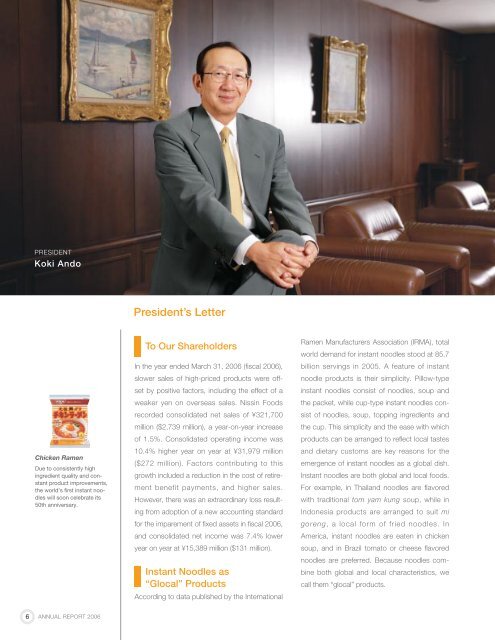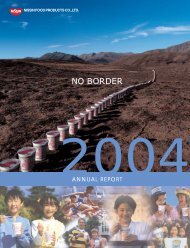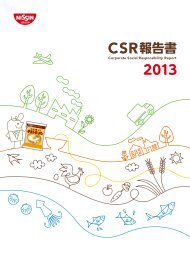NO BORDER
NO BORDER
NO BORDER
Create successful ePaper yourself
Turn your PDF publications into a flip-book with our unique Google optimized e-Paper software.
PRESIDENT<br />
Koki Ando<br />
President’s Letter<br />
Chicken Ramen<br />
Due to consistently high<br />
ingredient quality and constant<br />
product improvements,<br />
the world’s first instant noodles<br />
will soon celebrate its<br />
50th anniversary.<br />
To Our Shareholders<br />
In the year ended March 31, 2006 (fiscal 2006),<br />
slower sales of high-priced products were offset<br />
by positive factors, including the effect of a<br />
weaker yen on overseas sales. Nissin Foods<br />
recorded consolidated net sales of ¥321,700<br />
million ($2,739 million), a year-on-year increase<br />
of 1.5%. Consolidated operating income was<br />
10.4% higher year on year at ¥31,979 million<br />
($272 million). Factors contributing to this<br />
growth included a reduction in the cost of retirement<br />
benefit payments, and higher sales.<br />
However, there was an extraordinary loss resulting<br />
from adoption of a new accounting standard<br />
for the imparement of fixed assets in fiscal 2006,<br />
and consolidated net income was 7.4% lower<br />
year on year at ¥15,389 million ($131 million).<br />
Instant Noodles as<br />
“Glocal” Products<br />
According to data published by the International<br />
Ramen Manufacturers Association (IRMA), total<br />
world demand for instant noodles stood at 85.7<br />
billion servings in 2005. A feature of instant<br />
noodle products is their simplicity. Pillow-type<br />
instant noodles consist of noodles, soup and<br />
the packet, while cup-type instant noodles consist<br />
of noodles, soup, topping ingredients and<br />
the cup. This simplicity and the ease with which<br />
products can be arranged to reflect local tastes<br />
and dietary customs are key reasons for the<br />
emergence of instant noodles as a global dish.<br />
Instant noodles are both global and local foods.<br />
For example, in Thailand noodles are flavored<br />
with traditional tom yam kung soup, while in<br />
Indonesia products are arranged to suit mi<br />
goreng, a local form of fried noodles. In<br />
America, instant noodles are eaten in chicken<br />
soup, and in Brazil tomato or cheese flavored<br />
noodles are preferred. Because noodles combine<br />
both global and local characteristics, we<br />
call them “glocal” products.<br />
6 ANNUAL REPORT 2006





